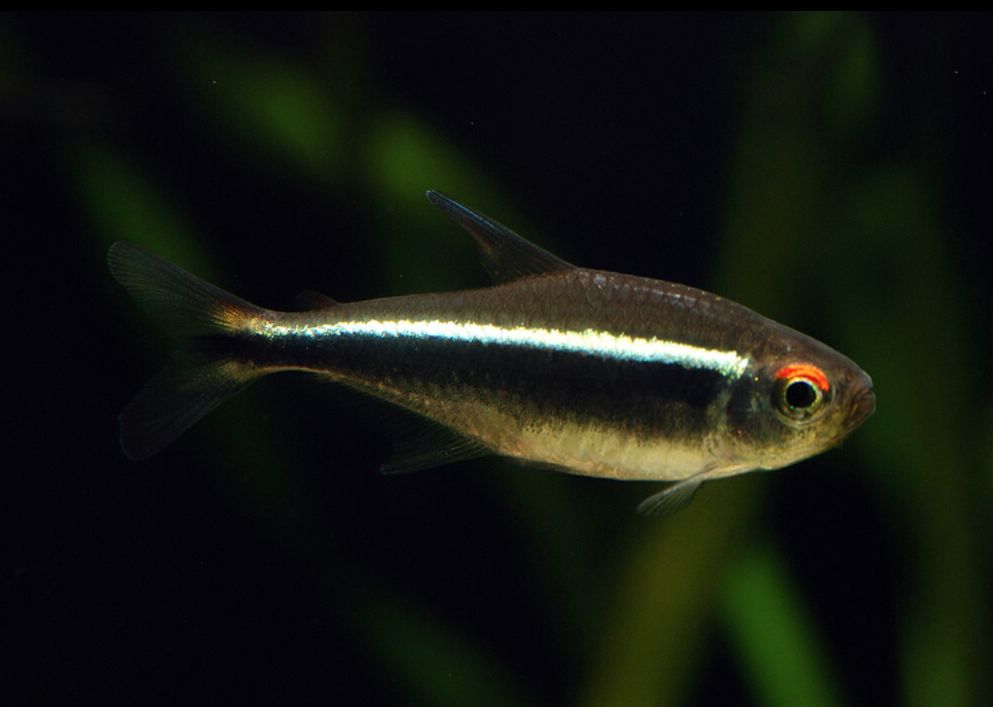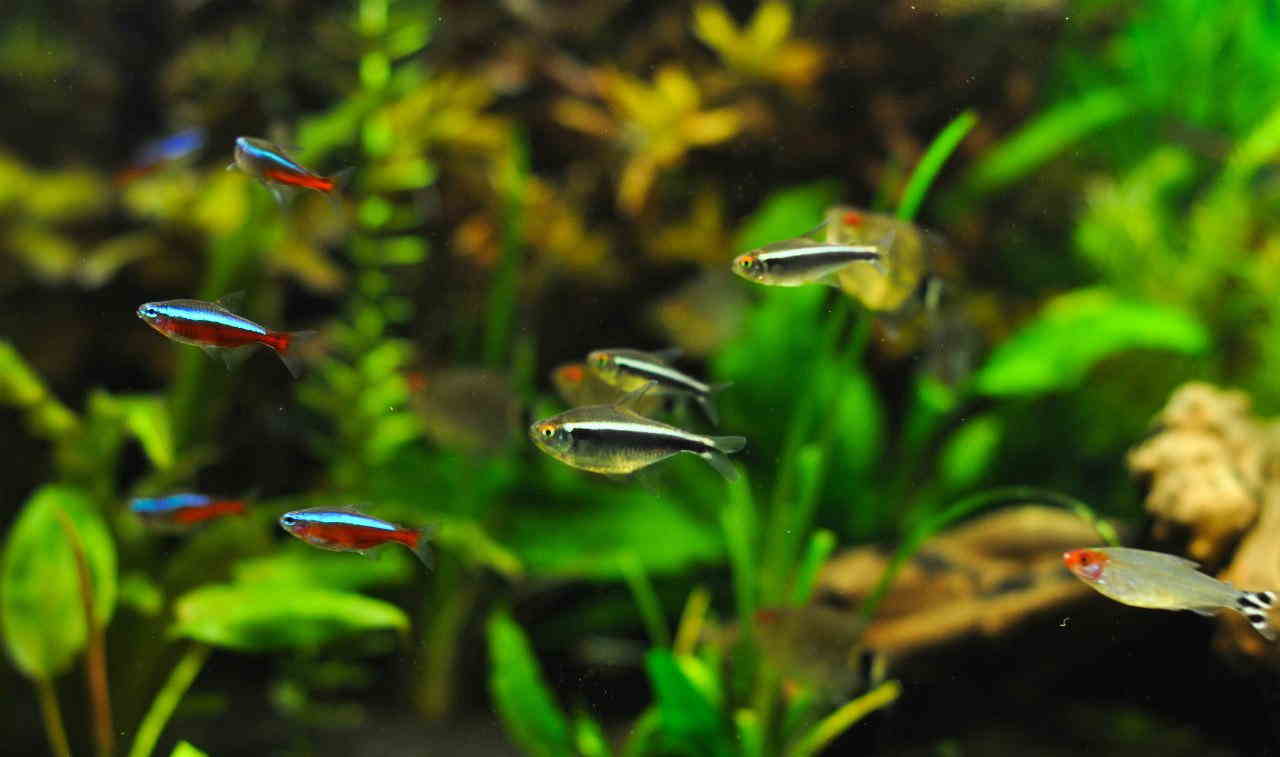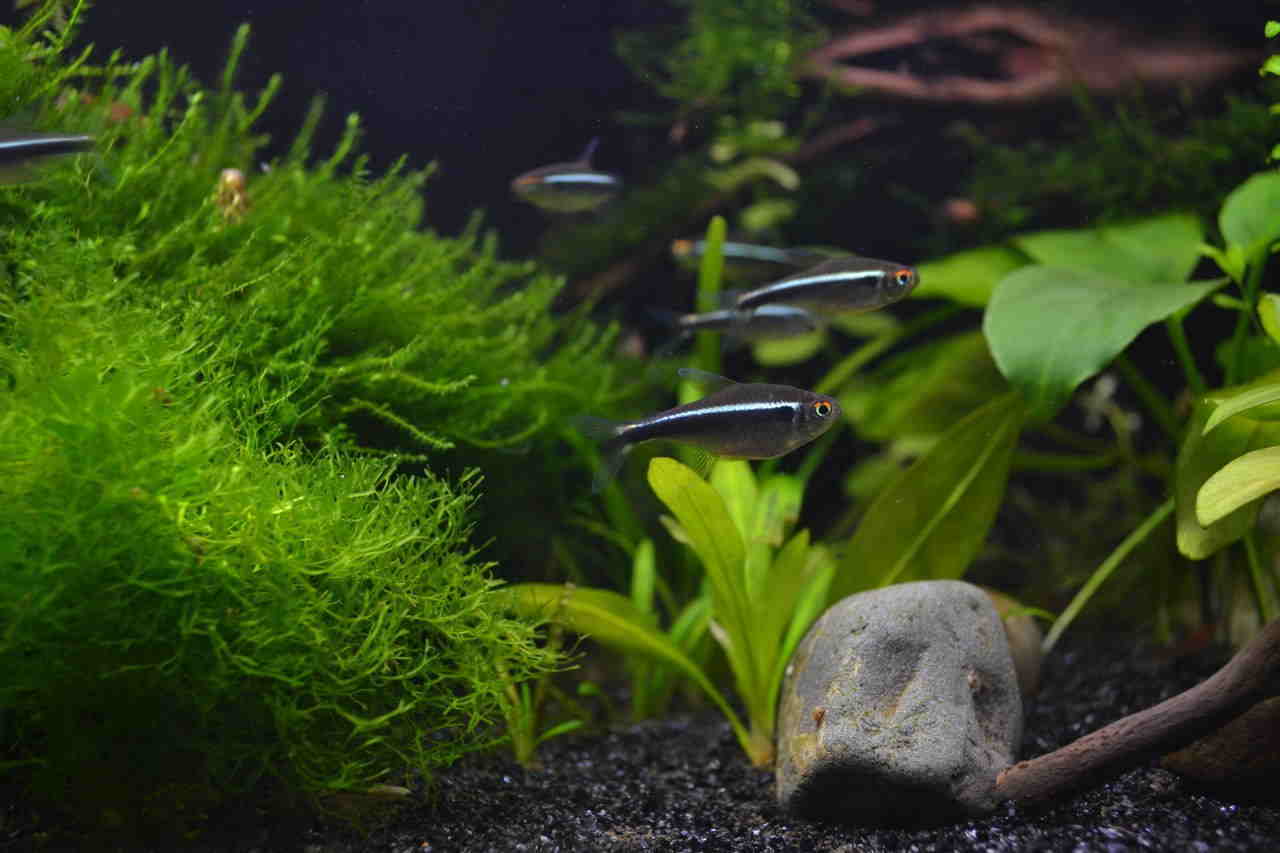The black neon tetra (Hyphessobrycon herbertaxelrodi) is a graceful and vibrant addition to any aquarium. When kept in a well-planted tank with a dark substrate, a school of these tetras creates a stunning visual effect, highlighting their striking appearance.
These tetras are not only beautiful but also prized for their peaceful temperament, making them excellent tank mates for a variety of other fish. Their deep black bodies, accentuated by a brilliant neon blue stripe, create a captivating contrast that makes them a favorite among aquarium enthusiasts.

Contents
Habitat in the wild
The black neon tetra (Hyphessobrycon herbertaxelrodi) is native to the Amazon River basin and its tributaries in South America. Specifically, it is found in Brazil within the Rio-Paraguay and Rio-Taquari river basins, located in the Mato Grosso do Sul state, and in the expansive Pantanal wetland park, which spans over 200,000 square kilometers.
In their natural habitat, black neon tetras thrive in shallow tributaries, bays, flooded forest areas, and shoals. These environments are typically densely vegetated, featuring an abundance of floating plants, submerged roots, and leaf litter. Such conditions provide essential hiding spots, shade, and natural filtration.
Black neon tetras are commonly found in slow-moving or still waters, such as oxbow lakes, flooded areas, and calm sections of streams. They are not strong swimmers and prefer tranquil water conditions. The water in their native biotope is usually acidic and brown-colored, a result of tannins and other chemicals leaching from decaying organic matter.

Description
Size
The black neon tetra is a small, elegant fish, typically reaching an average size of up to 1.5 inches (3.8 centimeters) as an adult. While this is the general size, individual fish can vary slightly, with some growing a bit larger or smaller within this range.
Lifespan
The average lifespan of black neon tetras is typically between 3 to 5 years when kept in well-maintained aquarium conditions.
Body and color
Black neon tetras have a slender, elongated body shape, characteristic of many tetra species, which makes them adept at swimming in small schools and maneuvering through dense vegetation in their natural habitat. Their bodies are primarily a deep black, but they are most captivating due to the vibrant neon blue line that runs horizontally along their midsection. This striking blue line contrasts sharply with their dark background, creating a visually stunning effect.
| Characteristic | Description |
|---|---|
| Scientific Name | Hyphessobrycon herbertaxelrodi |
| Common Name | Black Neon Tetra |
| Adult Size | Up to 1.5 inches (3.8 cm) |
| Lifespan | 3-5 years |
| Body Shape | Slender, elongated |
| Coloration | Deep black body with a vibrant neon blue line |
| Temperament | Peaceful, schooling |
| Preferred Water Parameters | Temperature: 72-82°F (22-28°C), pH: 5.5-7.0, Hardness: 2-10 dGH |
| Diet | Omnivorous, primarily microorganisms and small invertebrates |
| Tank Size | Minimum 10 gallons for a small school (larger tank for larger schools) |
| Tank Mates | Peaceful community fish, avoid fin nippers |
| Breeding Habits | Egg scatterers, non-guarding parents |
| Special Considerations | Sensitive to water quality and fluctuations. Appreciates a well-planted tank with hiding spots and subdued lighting |
Back neon tetra vs neon tetra
The black neon tetra and the neon tetra are two distinct species that are often compared due to their similar names and some visual similarities. Despite the resemblance in their names and the presence of a stripe on their bodies, they are different species.
The black neon tetra is named for its similarity to the neon tetra, but they differ significantly in appearance. While both species have a stripe running along their bodies, the black neon tetra has a deep black body contrasted by a vibrant neon blue stripe. In contrast, the neon tetra features a bright blue body with a red stripe. This color difference makes it relatively easy to distinguish between the two species despite their similarities.
| Characteristic | Black Neon Tetra | Neon Tetra |
|---|---|---|
| Scientific Name | Hyphessobrycon herbertaxelrodi | Paracheirodon innesi |
| Body Coloration | Deep black body with neon blue line | Silver body with horizontal red-blue stripe |
| Size | Up to 1.5 inches (3.8 cm) | Up to 1.2 inches (3 cm) |
| Natural Habitat | Amazon River basin and tributaries | Amazon River basin and tributaries |
| Temperament | Peaceful, schooling | Peaceful, schooling |
| Water Temperature Range | 72-82°F (22-28°C) | 72-80°F (22-26°C) |
| pH Range | 5.5-7.0 | 6.0-7.0 |
| Hardness Tolerance | 2-10 dGH | 1-10 dGH |
| Lifespan | 3-5 years | 2-3years |


Care and keeping in a tank
Tank size
A minimum tank size of 10 gallons (about 38 liters) is recommended for black neon tetras. However, a 20-gallon tank is ideal for housing a small school of these fish. If you plan to keep a larger school or include other fish species, a larger aquarium will be necessary to ensure ample space and maintain a healthy environment.
Tank decor
The best of their coloring the fishes show in a tank recreating the river Rio-Paraguay biotope. In this case put some river sand on a tank bottom, then some snags and branched roots. It’s also desirable to put some floating plants in it and some fallen tree leaves on its bottom.
The organic mass put into the tank will make the tank water obtain the color of lightly brewed tea. To avoid rotting of organics and the water contamination, renew the fallen leaves every several weeks. To make the tank water dark you can also put a turfy substrate into the filter. The tank lighting is better to be dim.
Since the fish is quite active, it should have some space for swimming in the tank and the tank should be closed, because the fish can also jump.
Water parameters
Ideally, the water temperature should be maintained within the range of 72-82°F (22-28°C). This range mimics the tropical conditions of their natural habitat in the Amazon River basin. Black Neon Tetras prefer slightly acidic to neutral water. The optimal pH range for them is around 5.5-7.0.
These tetras are adaptable to a range of water hardness levels. However, they tend to prefer soft to moderately hard water, with a hardness range of 2-10 dGH (degrees of general hardness).
Water filtration and slow water flow are desirable as well as weekly water renew up to 25% from the total tank capacity.
However, nowadays black neon tetras are bred in huge numbers for sale, so the fish has already become adapted to local conditions rather well.
Diet
Black neon tetras are omnivorous and can thrive on a variety of foods, including live, frozen, and pellet options. High-quality flakes or pellet foods designed for tropical fish should form the basis of their diet. Choose products specifically formulated to meet the nutritional needs of small tropical fish.
Given their small mouths, it’s important to select appropriately sized food. Supplementing their diet with live or frozen foods can add extra nutrients and variety. They particularly enjoy small live or frozen options like brine shrimp, daphnia, bloodworms, and mosquito larvae, which can be offered as occasional treats.
Tank mates
Black neon tetra is an ideal candidate for community tanks with other peaceful fishes. This is one of the best tetra fishes, since it’s very active, good looking and, again, peaceful. The only drawback, that they may haunt shrimps, especially the small ones – like red cherry shrimp.
It seems strange, since other species of neon fishes – neon tetra and cardinal tetra don’t do so. It’s important to have a school of 7 tetras, because only this way their beautiful coloring can be seen.
Sometimes they may damage other fishes fins (nipping), but when the fish is in the school such a behavior disappears. The best tank mates are platy, black tetra, tiger barb, dwarf gourami, Acanthophthalmus kuhlii (kuhlii loach).
Gender differences: male vs female
Telling male and female black neon tetras apart can be challenging, as they don’t show significant differences in coloration or fin shape.
However, there are a few subtle distinctions to look for. Typically, females have a more rounded abdomen and are generally larger than males. Males, on the other hand, tend to have a slimmer, more streamlined body. These differences might not be easily noticeable, especially in younger or smaller fish.
During breeding, males may display more vibrant coloration and exhibit increased territorial behavior. They might chase females or perform courtship displays to attract a mate. These behavioral changes are generally temporary and most noticeable during the breeding season.
Breeding
Breeding is rather difficult and time-consuming thing. The black neon tetra may lay the eggs all year round, but it happens mainly in spring and summer, since in the wild there a lot of insects that fall into the water during summer.
A spawning pond for 3-4 breeding fish has to be of 2 gallons capacity and the water level in it shouldn’t be more than 20 cm. If you want your black neon tetras to breed you should have water that has been settled for 2 weeks with the following chemical parameters:
- water hardness: 2-12 dH;
- acidity: 6,2-6,6;
- temperature: 24-26 C.
A spawning tank should be put in place shaded from sun rays and the tank should be shaded from all sides. The fattest females and the most active males are selected for breeding.
The future breeders must be kept apart for about a week and fed well. The day before breeding you should stop feeding the black neon tetra. The fishes start laying eggs since morning and the process lasts for 2-3 days. Spawning itself lasts for 1.5-2 hours and the rest continues the next day. For one spawning female may lay from 100 to 200 transparent eggs.
As soon as the fishes finish breeding they are removed from the spawning pond and the latter gets shaded. The eggs incubation time is about 1-2 days. 4-5 days later larva may be able to swim and feed on their own. This is the time when some moderate light may get access into the tank.
First, you should feed black neon tetra juveniles with infusorians, rotifers, small crustacean nauplii and as the juveniles grow some vegetable feed is added to the diet. The juveniles grow rather fast and for the first 2 weeks they usually hide under the tank plants leaves.
At first black neon tetra juveniles are of gray color with dark horizontal stripes. When they become 3 weeks old sparkling and black stripes will appear on their body, their eyes will change their color.
At the age of 5 weeks the juveniles coloring will look like the one of adult and they can be put into community tank. However, quite often black juveniles suffer from so called Neon Tetra Disease, that shows in the change of the coloring.
Sadly, this disease inevitably leads to the death. Therefore, it’s better to remove the infected fish from the others right away. Becomes reproductive at the age of 10-11 month.